Determining Fire Dates and Locating Ignition Points With Satellite Data
Abstract
:1. Introduction
2. Materials and Methods
2.1. Study Areas and Fire Databases
2.2. Satellite Data
2.3. Wildfire Dates
2.4. Wildfire Ignitions
2.5. Assessment of Satellite-Derived Wildfire Dates and Ignitions
2.6. Limitations of Satellite Data to Derive Wildfire Dates and Ignition
- Persistent cloud cover, if the average cloud cover affecting the fire perimeter between the reported start and end dates was higher than 80%.
- Small fire, if the burnt area was smaller than 500 ha (larger than 200 ha, see Section 2.3).
- Short duration, if the reported fire duration was shorter than 12 h.
- Unknown, if none of the above conditions were verified.
- 5.
- Insufficient information, if active fires were detected only for one satellite overpass.
- 6.
- Multiple fire events, if the minimum frequency of the largest temporal cluster was below minD (see Section 2.3).
3. Results
3.1. The Potential of Satellite Data
3.2. Assessment and Uncertainty Analysis
3.2.1. Fire Dates
3.2.2. Fire Ignitions
3.3. Limitations of Satellite Data
4. Discussion
4.1. Potential and Limitations of Satellite Data
4.2. Future Research Directions
5. Conclusions
Supplementary Materials
Acknowledgments
Author Contributions
Conflicts of Interest
Abbreviations
| USA | United States of America |
| SE | Southeastern |
| ICNF | Instituto de Conservação da Natureza e Florestas |
| AICC | Alaska Interagency Coordination Center |
| NSW | New South Wales |
| MODIS | MODerate Resolution Imaging Spectroradiometer |
| ASTER | Advanced Spaceborne Thermal Emission and Reflection Radiometer |
| MEF | Nash–Sutcliffe Model Efficiency index |
| VIIRS | Visible Infrared Imaging Radiometer Suite |
| MFG | Meteosat First Generation |
| MSG | Meteosat Second Generation |
| GOES | Geostationary Operational Environmental Satellite |
References
- Van der Werf, G.R.; Randerson, J.T.; Giglio, L.; Collatz, G.J.; Mu, M.; Kasibhatla, P.S.; Morton, D.C.; Defries, R.S.; Jin, Y.; van Leeuwen, T.T. Global fire emissions and the contribution of deforestation, savanna, forest, agricultural, and peat fires (1997–2009). Atmos. Chem. Phys. 2010, 10, 11707–11735. [Google Scholar] [CrossRef]
- Lentile, L.B.; Holden, Z.A.; Smith, A.M.S.; Falkowski, M.J.; Hudak, A.T.; Morgan, P.; Lewis, S.A.; Gessler, P.E.; Benson, N.C. Remote sensing techniques to assess active fire characteristics and post-fire effects. Int. J. Wildland Fire 2006, 15, 319–345. [Google Scholar] [CrossRef]
- French, N.H.; de Groot, W.J.; Jenkins, L.K.; Rogers, B.M.; Alvarado, E.; Amiro, B.; De Jong, B.; Goetz, S.; Hoy, E.; Hyer, E.; et al. Model comparisons for estimating carbon emissions from North American wildland fire. J. Geophys. Res. 2011, 116, G00K05. [Google Scholar] [CrossRef]
- Giglio, L.; Kendall, J.; Justice, C. Evaluation of global fire detection algorithms using simulated AVHRR infrared data. Int. J. Remote Sens. 1999, 20, 1947–1985. [Google Scholar] [CrossRef]
- Ganteaume, A.; Camia, A.; Jappiot, M.; San-Miguel-Ayanz, J.; Long-Fournel, M.; Lampin, C. A review of the main driving factors of forest fire ignition over Europe. Environ. Manag. 2013, 51, 651–662. [Google Scholar] [CrossRef] [PubMed]
- Bar-Massada, A.; Hawbaker, T.J.; Stewart, S.I.; Radeloff, V.C. Combining satellite-based fire observations and ground-based lightning detections to identify lightning fires across the conterminous USA. IEEE J. Sel. Top. Appl. Earth Obs. Remote Sens. 2012, 5, 1438–1447. [Google Scholar] [CrossRef]
- Moreira, F.; Catry, F.X.; Rego, F.; Bacao, F. Size-dependent pattern of wildfire ignitions in Portugal: When do ignitions turn into big fires? Landsc. Ecol. 2010, 25, 1405–1417. [Google Scholar] [CrossRef]
- Catry, F.X.; Rego, F.C.; Bação, F.L.; Moreira, F. Modeling and mapping wildfire ignition risk in portugal. Int. J. Wildl. Fire 2009, 18, 921–931. [Google Scholar] [CrossRef]
- Salis, M.; Ager, A.A.; Arca, B.; Finney, M.A.; Bacciu, V.; Duce, P.; Spano, D. Assessing exposure of human and ecological values to wildfire in Sardinia, Italy. Int. J. Wildl. Fire 2013, 22, 549–565. [Google Scholar] [CrossRef]
- Pereira, M.G.; Malamud, B.D.; Trigo, R.M.; Alves, P.I. The history and characteristics of the 1980–2005 Portuguese rural fire database. Nat. Hazards Earth Syst. Sci. 2011, 11, 3343–3358. [Google Scholar] [CrossRef]
- Parisien, M.-A.; Parks, S.A.; Miller, C.; Krawchuk, M.A.; Heathcott, M.; Moritz, M.A. Contributions of ignitions, fuels, and weather to the spatial patterns of burn probability of a boreal landscape. Ecosystems 2011, 14, 1141–1155. [Google Scholar] [CrossRef]
- Lavoué, D.; Gong, S.; Stocks, B.J. Modelling emissions from Canadian wildfires: A case study of the 2002 quebec fires. Int. J. Wildl. Fire 2008, 16, 649–663. [Google Scholar] [CrossRef]
- Thompson, J.R.; Spies, T.A. Factors associated with crown damage following recurring mixed-severity wildfires and post-fire management in southwestern Oregon. Landsc. Ecol. 2010, 25, 775–789. [Google Scholar] [CrossRef]
- Cary, G.J.; Flannigan, M.D.; Keane, R.E.; Bradstock, R.A.; Davies, I.D.; Lenihan, J.M.; Li, C.; Logan, K.A.; Parsons, R.A. Relative importance of fuel management, ignition management and weather for area burned: Evidence from five landscape–fire–succession models. Int. J. Wildl. Fire 2009, 18, 147–156. [Google Scholar] [CrossRef]
- Slocum, M.G.; Beckage, B.; Platt, W.J.; Orzell, S.L.; Taylor, W. Effect of climate on wildfire size. Ecosystems 2010, 13, 828–840. [Google Scholar] [CrossRef]
- Bar-Massada, A.; Syphard, A.D.; Hawbaker, T.J.; Stewart, S.I.; Radeloff, V.C. Effects of ignition location models on the burn patterns of simulated wildfires. Environ. Model. Softw. 2011, 26, 583–592. [Google Scholar] [CrossRef]
- LaCroix, J.J.; Ryu, S.-R.; Zheng, D.; Chen, J. Simulating fire spread with landscape management scenarios. For. Sci. 2006, 52, 522–529. [Google Scholar]
- Shapiro-Miller, L.B.; Heyerdahl, E.K.; Morgan, P. Comparison of fire scars, fire atlases, and satellite data in the northwestern United States. Can. J. For. Res. 2007, 37, 1933–1943. [Google Scholar] [CrossRef]
- Morgan, P.; Hardy, C.C.; Swetnam, T.W.; Rollins, M.G.; Long, D.G. Mapping fire regimes across time and space: Understanding coarse and fine-scale fire patterns. Int. J. Wildl. Fire 2001, 10, 329–342. [Google Scholar] [CrossRef]
- Amatulli, G.; Peréz-Cabello, F.; de la Riva, J. Mapping lightning/human-caused wildfires occurrence under ignition point location uncertainty. Ecol. Model. 2007, 200, 321–333. [Google Scholar] [CrossRef]
- Short, K.C. A spatial database of wildfires in the United States, 1992–2011. Earth Syst. Sci. Data 2014, 6, 1–27. [Google Scholar] [CrossRef]
- Kasischke, E.S.; Williams, D.; Barry, D. Analysis of the patterns of large fires in the boreal region of Alaska. Int. J. Wildl. Fire 2002, 11, 131–144. [Google Scholar] [CrossRef]
- Hawbaker, T.J.; Radeloff, V.C.; Syphard, A.D.; Zhu, Z.; Stewart, S.I. Detection rates of the MODIS active fire product in the United States. Remote Sens. Environ. 2008, 112, 2656–2664. [Google Scholar] [CrossRef]
- Holden, Z.; Smith, A.; Morgan, P.; Rollins, M.; Gessler, P. Evaluation of novel thermally enhanced spectral indices for mapping fire perimeters and comparisons with fire atlas data. Int. J. Remote Sens. 2005, 26, 4801–4808. [Google Scholar] [CrossRef]
- Thorsteinsson, T.; Magnusson, B.; Gudjonsson, G. Large wildfire in Iceland in 2006: Size and intensity estimates from satellite data. Int. J. Remote Sens. 2011, 32, 17–29. [Google Scholar] [CrossRef]
- Lee, B.S.; Alexander, M.E.; Hawkes, B.C.; Lynham, T.J.; Stocks, B.J.; Englefield, P. Information systems in support of wildland fire management decision making in Canada. Comput. Electron. Agric. 2002, 37, 185–198. [Google Scholar] [CrossRef]
- Loboda, T.V.; Csiszar, I.A. Reconstruction of fire spread within wildland fire events in Northern Eurasia from the MODIS active fire product. Glob. Planet. Chang. 2007, 56, 258–273. [Google Scholar] [CrossRef]
- Parks, S.A. Mapping day-of-burning with coarse-resolution satellite fire-detection data. Int. J. Wildl. Fire 2014, 23, 215–223. [Google Scholar] [CrossRef]
- Veraverbeke, S.; Sedano, F.; Hook, S.J.; Randerson, J.T.; Jin, Y.; Rogers, B.M. Mapping the daily progression of large wildland fires using MODIS active fire data. Int. J. Wildl. Fire 2014, 23, 655–667. [Google Scholar] [CrossRef]
- Chuvieco, E.; Martin, M. A simple method for area growth mapping using AVHRR channel 3 data. Int. J. Remote Sens. 1994, 15, 3141–3146. [Google Scholar] [CrossRef]
- Smith, A.M.S.; Wooster, M.J. Remote classification of head and backfire types from MODIS fire radiative power and smoke plume observations. Int. J. Wildl. Fire 2005, 14, 249–254. [Google Scholar] [CrossRef]
- Dennison, P.E.; Charoensiri, K.; Roberts, D.A.; Peterson, S.H.; Green, R.O. Wildfire temperature and land cover modeling using hyperspectral data. Remote Sens. Environ. 2006, 100, 212–222. [Google Scholar] [CrossRef]
- Wooster, M.; Zhukov, B.; Oertel, D. Fire radiative energy for quantitative study of biomass burning: Derivation from the bird experimental satellite and comparison to MODIS fire products. Remote Sens. Environ. 2003, 86, 83–107. [Google Scholar] [CrossRef]
- Keeley, J.E.; Fotheringham, C.J. Historic fire regime in southern california shrublands. Conserv. Biol. 2001, 15, 1536–1548. [Google Scholar] [CrossRef]
- Dimitrakopoulos, A.P.; Vlahou, M.; Anagnostopoulou, C.G.; Mitsopoulos, I. Impact of drought on wildland fires in greece: Implications of climatic change? Clim. Change 2011, 109, 331–347. [Google Scholar] [CrossRef]
- Trigo, R.M.; Pereira, J.M.C.; Pereira, M.G.; Mota, B.; Calado, T.J.; da Camara, C.C.; Santo, F.E. Atmospheric conditions associated with the exceptional fire season of 2003 in portugal. Int. J. Climatol. 2006, 26, 1741–1757. [Google Scholar] [CrossRef]
- Trigo, R.M.; Sousa, P.M.; Pereira, M.G.; Rasilla, D.; Gouveia, C.M. Modelling wildfire activity in iberia with different atmospheric circulation weather types. Int. J. Climatol. 2013. [Google Scholar] [CrossRef]
- Boschetti, L.; Roy, D.; Barbosa, P.; Boca, R.; Justice, C. A modis assessment of the summer 2007 extent burned in greece. Int. J. Remote Sens. 2008, 29, 2433–2436. [Google Scholar] [CrossRef]
- Keeley, J.E.; Safford, H.; Fotheringham, C.; Franklin, J.; Moritz, M. The 2007 southern california wildfires: Lessons in complexity. J. Forest. 2009, 107, 287–296. [Google Scholar]
- Keeley, J.E.; Fotheringham, C.; Moritz, M.A. Lessons from the october 2003. Wildfires in Southern California. J. Forest. 2004, 102, 26–31. [Google Scholar]
- Turetsky, M.R.; Kane, E.S.; Harden, J.W.; Ottmar, R.D.; Manies, K.L.; Hoy, E.; Kasischke, E.S. Recent acceleration of biomass burning and carbon losses in alaskan forests and peatlands. Nat. Geosci. 2011, 4, 27–31. [Google Scholar] [CrossRef]
- Loboda, T.V.; Hoy, E.E.; Giglio, L.; Kasischke, E.S. Mapping burned area in alaska using modis data: A data limitations-driven modification to the regional burned area algorithm. Int. J. Wildl. Fire 2011, 20, 487–496. [Google Scholar] [CrossRef]
- Sullivan, A.L.; McCaw, W.L.; Cruz, M.G.; Matthews, S.; Ellis, P.F. Fuel, fire weather and fire behaviour in australian ecosystems. In Flammable Australia: Fire Regimes, Biodiversity and Ecosystems in a Changing World; CSIRO Publishing: Melbourne, Australia, 2012; pp. 51–79. [Google Scholar]
- Cruz, M.G.; Sullivan, A.L.; Gould, J.S.; Sims, N.C.; Bannister, A.J.; Hollis, J.J.; Hurley, R.J. Anatomy of a catastrophic wildfire: The black saturday kilmore east fire in victoria, australia. For. Ecol. Manag. 2012, 284, 269–285. [Google Scholar] [CrossRef]
- INCF. Available online: http://www.icnf.pt/portal/florestas/dfci/inc/estat-sgif (accessed on 10 February 2016).
- Oliveira, S.L.J.; Pereira, J.M.C.; Carreiras, J.M.B. Fire frequency analysis in Portugal (1975–2005), using Landsat-based burnt area maps. Int. J. Wildl. Fire 2012, 21, 48–60. [Google Scholar] [CrossRef]
- AICC. Available online: http://fire.ak.blm.gov/ (accessed on 10 February 2016).
- CALFIRE. Available online: http://frap.cdf.ca.gov/data/ (accessed on 10 February 2016).
- Koutsias, N.; Pleniou, M.; Mallinis, G.; Nioti, F.; Sifakis, N.I. A rule-based semi-automatic method to map burned areas: Exploring the usgs historical Landsat archives to reconstruct recent fire history. Int. J. Remote Sens. 2013, 34, 7049–7068. [Google Scholar] [CrossRef]
- Pleniou, M.; Xystrakis, F.; Dimopoulos, P.; Koutsias, N. Maps of fire occurrence—Spatially explicit reconstruction of recent fire history using satellite remote sensing. J. Maps 2013, 8, 499–506. [Google Scholar] [CrossRef]
- Giglio, L.; Descloitres, J.; Justice, C.O.; Kaufman, Y.J. An enhanced contextual fire detection algorithm for MODIS. Remote Sens. Environ. 2003, 87, 273–282. [Google Scholar] [CrossRef]
- Wolfe, R.E.; Roy, D.P.; Vermote, E. MODIS land data storage, gridding, and compositing methodology: Level 2 grid. IEEE Trans. Geosci. Remote Sens. 1998, 36, 1324–1338. [Google Scholar] [CrossRef]
- Ichoku, C.; Kaufman, Y.J. A method to derive smoke emission rates from MODIS fire radiative energy measurements. IEEE Trans. Geosci. Remote Sens. 2005, 43, 2636–2649. [Google Scholar] [CrossRef]
- Wan, Z. MODIS Land-Surface Temperature. Algorithm Theoretical Basis Document. Available online: http://modis.gsfc.nasa.gov/data/atbd/atbd_mod11.pdf (accessed on 1 August 2015).
- Schmidt, K.M.; Menakis, J.P.; Hardy, C.C.; Hann, W.J.; Bunnell, D.L. Development of Coarse-Scale Spatial Data for Wildland Fire and Fuel Management; General Technical Report; USDA Forest Service, Rocky Mountain Research Station: Fort Collins, CO, USA, 2002; p. 41. [Google Scholar]
- Nash, J.E.; Sutcliffe, J.V. River flow forecasting through conceptual models part I—A discussion of principles. J. Hydrol. 1970, 10, 282–290. [Google Scholar] [CrossRef]
- Turquety, S.; Logan, J.A.; Jacob, D.J.; Hudman, R.C.; Leung, F.Y.; Heald, C.L.; Yantosca, R.M.; Wu, S.; Emmons, L.K.; Edwards, D.P.; et al. Inventory of boreal fire emissions for north america in 2004: Importance of peat burning and pyroconvective injection. J. Geophys. Res. Atmos. 2007, 112, D12S03. [Google Scholar] [CrossRef]
- De Klerk, H. A pragmatic assessment of the usefulness of the MODIS (Terra and Aqua) 1-km active fire (MOD14A2 and MYD14A2) products for mapping fires in the fynbos biome. Int. J. Wildl. Fire 2008, 17, 166–178. [Google Scholar] [CrossRef]
- Benali, A.; Ervilha, A.R.; Sá, A.C.L.; Fernandes, P.M.; Pinto, R.M.S.; Trigo, R.M.; Pereira, J.M.C. Deciphering the impact of uncertainty on the accuracy of large wildfire spread simulations. Unpublished data. 2016. [Google Scholar]
- Giglio, L. MODIS Collection 5 Active Fire Product User’s Guide Version 2.4. 2010. Available online: http://www.fao.org/fileadmin/templates/gfims/docs/MODIS_Fire_Users_Guide_2.4.pdf (accessed on 12 April 2016).
- Giglio, L. Characterization of the tropical diurnal fire cycle using VIRS and MODIS observations. Remote Sens. Environ. 2007, 108, 407–421. [Google Scholar] [CrossRef]
- Schroeder, W.; Morisette, J.T.; Csiszar, I.; Giglio, L.; Morton, D.; Justice, C.O. Characterizing vegetation fire dynamics in brazil through multisatellite data: Common trends and practical issues. Earth Interact. 2005, 9, 1–26. [Google Scholar] [CrossRef]
- Morisette, J.; Giglio, L.; Csiszar, I.; Justice, C. Validation of the MODIS active fire product over southern Africa with ASTER data. Int. J. Remote Sens. 2005, 26, 4239–4264. [Google Scholar] [CrossRef]
- Morisette, J.T.; Giglio, L.; Csiszar, I.; Setzer, A.; Shroeder, W.; Morton, D.; Justice, C.O. Validation of MODIS active fire detection products derived from two algorithms. Earth Interact. 2005, 9, 1–25. [Google Scholar] [CrossRef]
- Csiszar, I.A.; Morisette, J.T.; Giglio, L. Validation of active fire detection from moderate-resolution satellite sensors: The MODIS example in northern Eurasia. IEEE Trans. Geosci. Remote Sens. 2006, 44, 1757–1764. [Google Scholar] [CrossRef]
- Hantson, S.; Padilla, M.; Corti, D.; Chuvieco, E. Strengths and weaknesses of MODIS hotspots to characterize global fire occurrence. Remote Sens. Environ. 2013, 131, 152–159. [Google Scholar] [CrossRef]
- Schroeder, W.; Oliva, P.; Giglio, L.; Csiszar, I.A. The new VIIRS 375m active fire detection data product: Algorithm description and initial assessment. Remote Sens. Environ. 2014, 143, 85–96. [Google Scholar] [CrossRef]
- Oliva, P.; Schroeder, W. Assessment of VIIRS 375m active fire detection product for direct burned area mapping. Remote Sens. Environ. 2015, 160, 144–155. [Google Scholar] [CrossRef]
- Amraoui, M.; Liberato, M.L.R.; Calado, T.J.; da Camara, C.C.; Coelho, L.P.; Trigo, R.M.; Gouveia, C.M. Fire activity over Mediterranean Europe based on information from Meteosat-8. For. Ecol. Manag. 2013, 294, 62–75. [Google Scholar] [CrossRef]
- Schroeder, W.; Csiszar, I.; Giglio, L.; Schmidt, C.C. On the use of fire radiative power, area, and temperature estimates to characterize biomass burning via moderate to coarse spatial resolution remote sensing data in Brazilian Amazon. J. Geophys. Res. 2010, 115, D21121. [Google Scholar] [CrossRef]
- Wooster, M.J.; Xu, W.; Nightingale, T. Sentinel-3 SLSTR active fire detection and FRP product: Pre-launch algorithm development and performance evaluation using MODIS and ASTER datasets. Remote Sens. Environ. 2012, 120, 236–254. [Google Scholar] [CrossRef]
- Freeborn, P.H.; Wooster, M.J.; Roberts, G.; Malamud, B.D.; Xu, W. Development of a virtual active fire product for Africa through a synthesis of geostationary and polar orbiting satellite data. Remote Sens. Environ. 2009, 113, 1700–1711. [Google Scholar] [CrossRef]
- Giglio, L.; Loboda, T.; Roy, D.P.; Quayle, B.; Justice, C.O. An active-fire based burned area mapping algorithm for the MODIS sensor. Remote Sens. Environ. 2009, 113, 408–420. [Google Scholar] [CrossRef]
- Roy, D.P.; Boschetti, L.; Justice, C.O.; Ju, J. The collection 5 MODIS burned area product—Global evaluation by comparison with the MODIS active fire product. Remote Sens. Environ. 2008, 112, 3690–3707. [Google Scholar] [CrossRef]
- Justice, C.O.; Giglio, L.; Korontzi, S.; Owens, J.; Morisette, J.T.; Roy, D.; Descloitres, J.; Alleaume, S.; Petitcolin, F.; Kaufman, Y. The MODIS fire products. Remote Sens. Environ. 2002, 83, 244–262. [Google Scholar] [CrossRef]
- Archibald, S.; Roy, D.P. Identifying individual fires from satellite-derived burned area data. In Proceedings of the 2009 IEEE International Geoscience and Remote Sensing Symposium (IGARSS 2009), Cape Town, South Africa, 12–17 July 2009.
- Price, O.F. Potential role of ignition management in reducing unplanned burning in Arnhem land, Australia. Austral Ecol. 2015, 40, 857–868. [Google Scholar] [CrossRef]
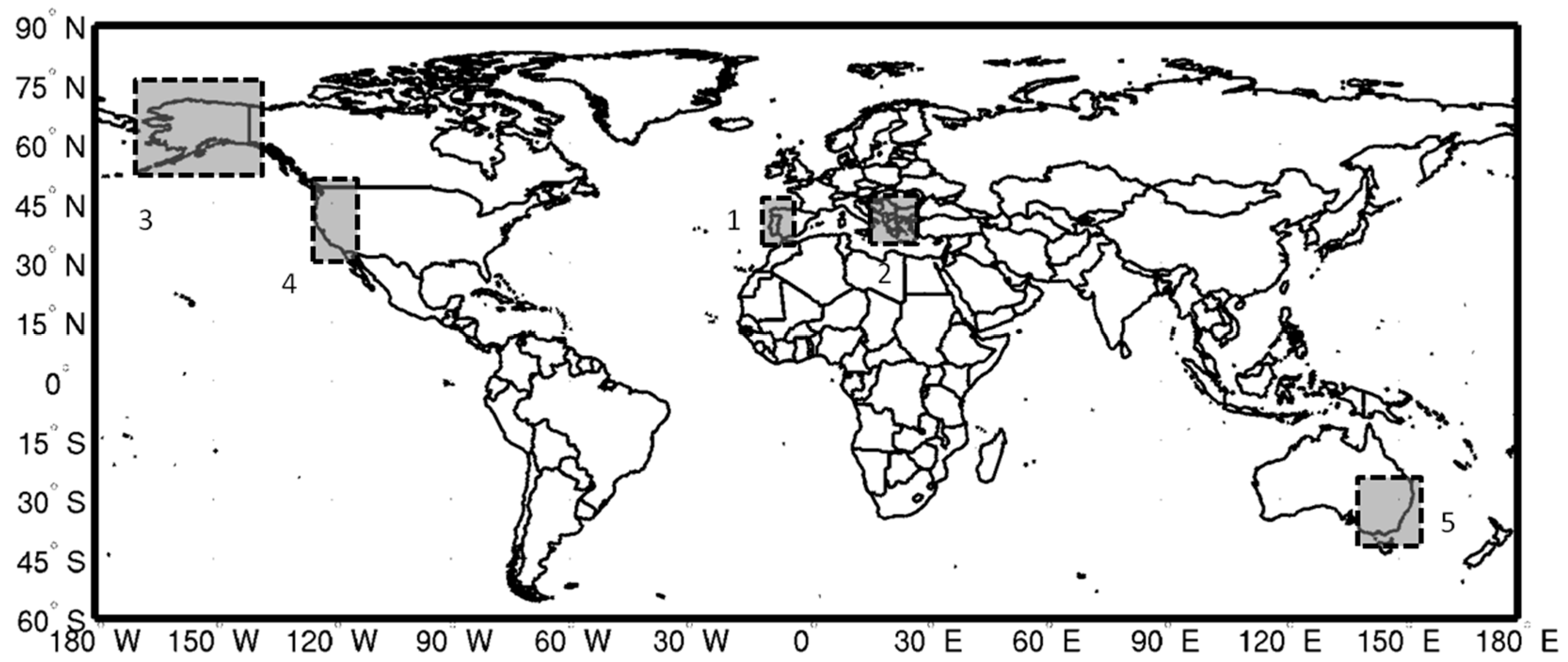
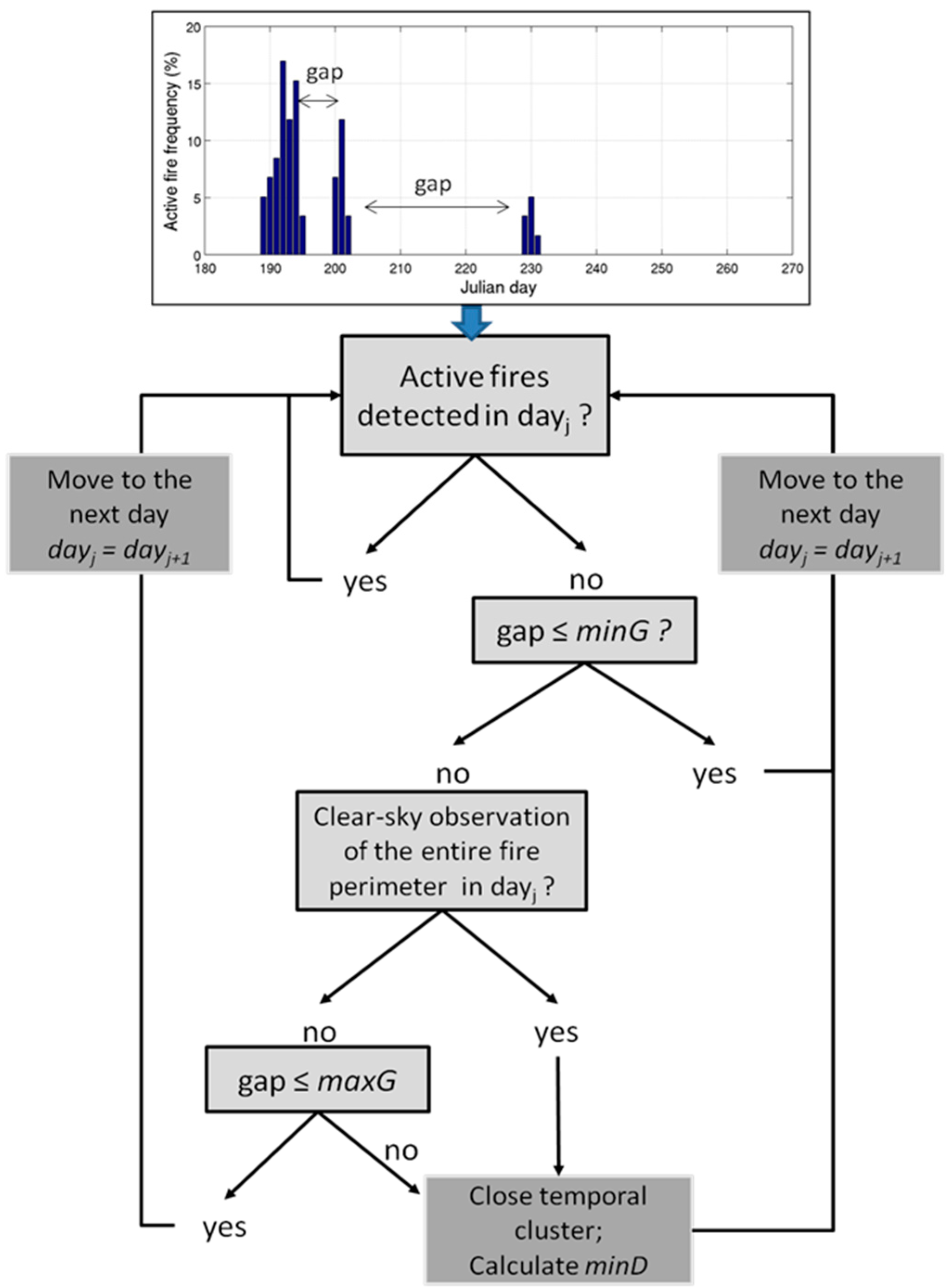
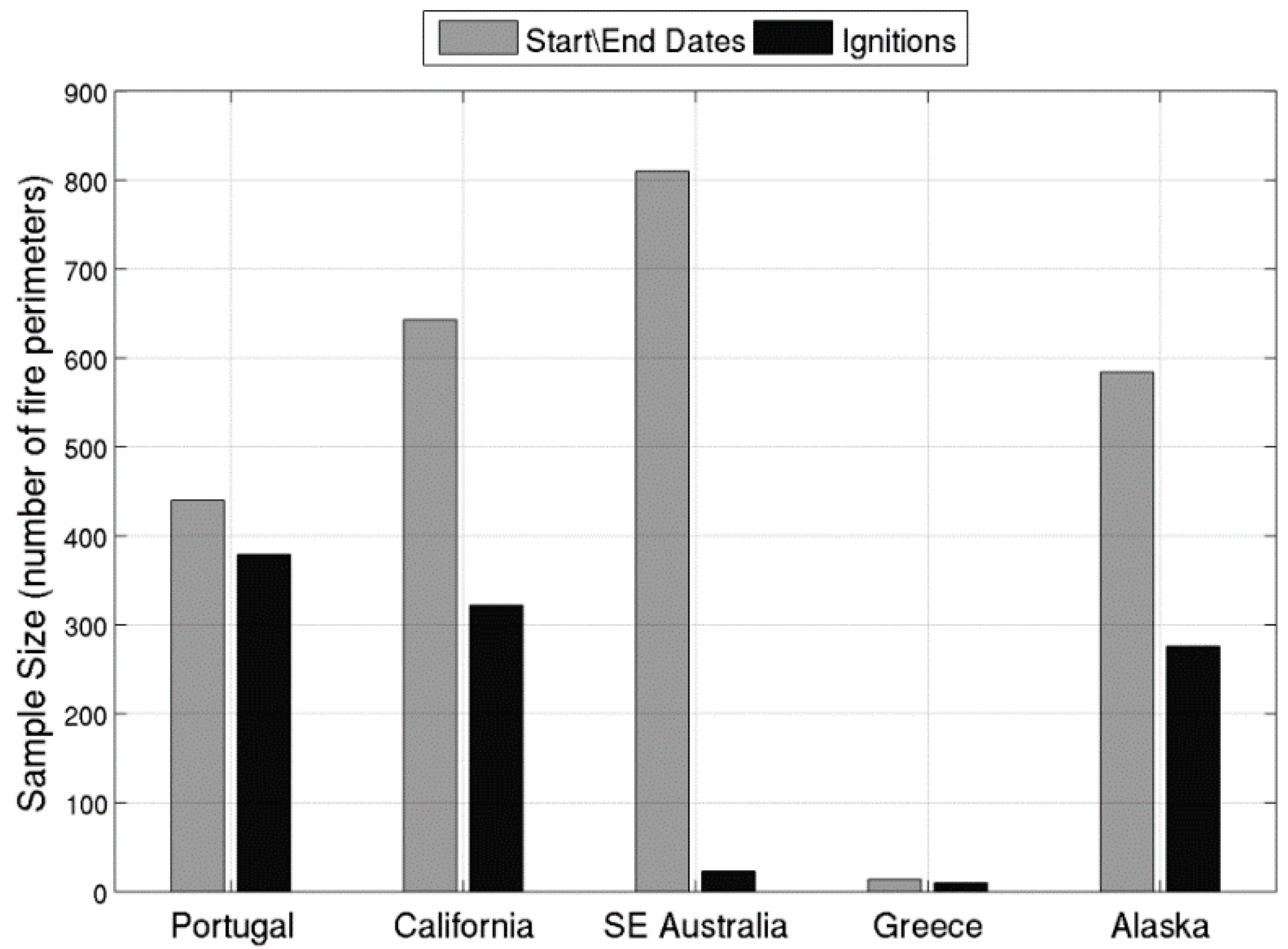
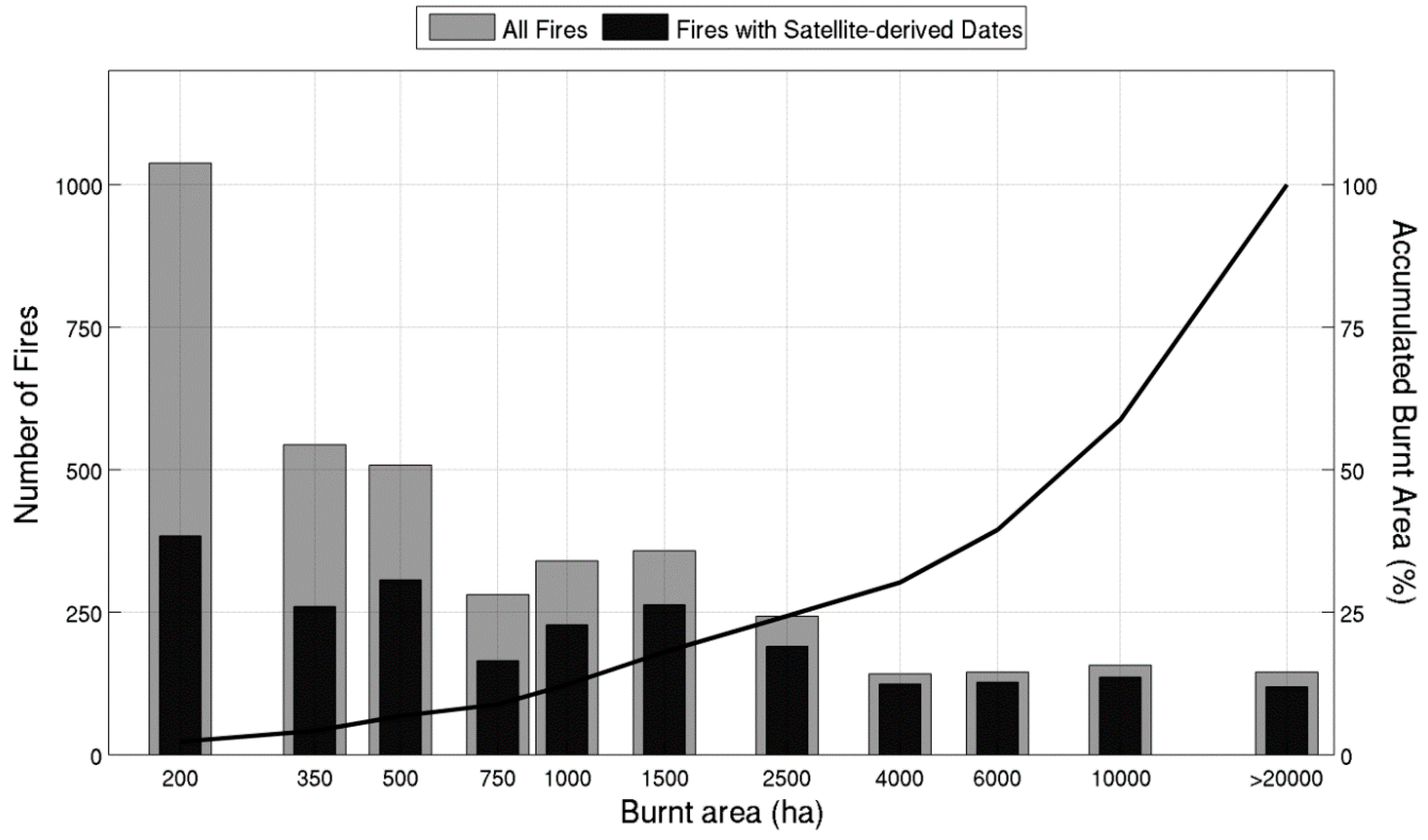
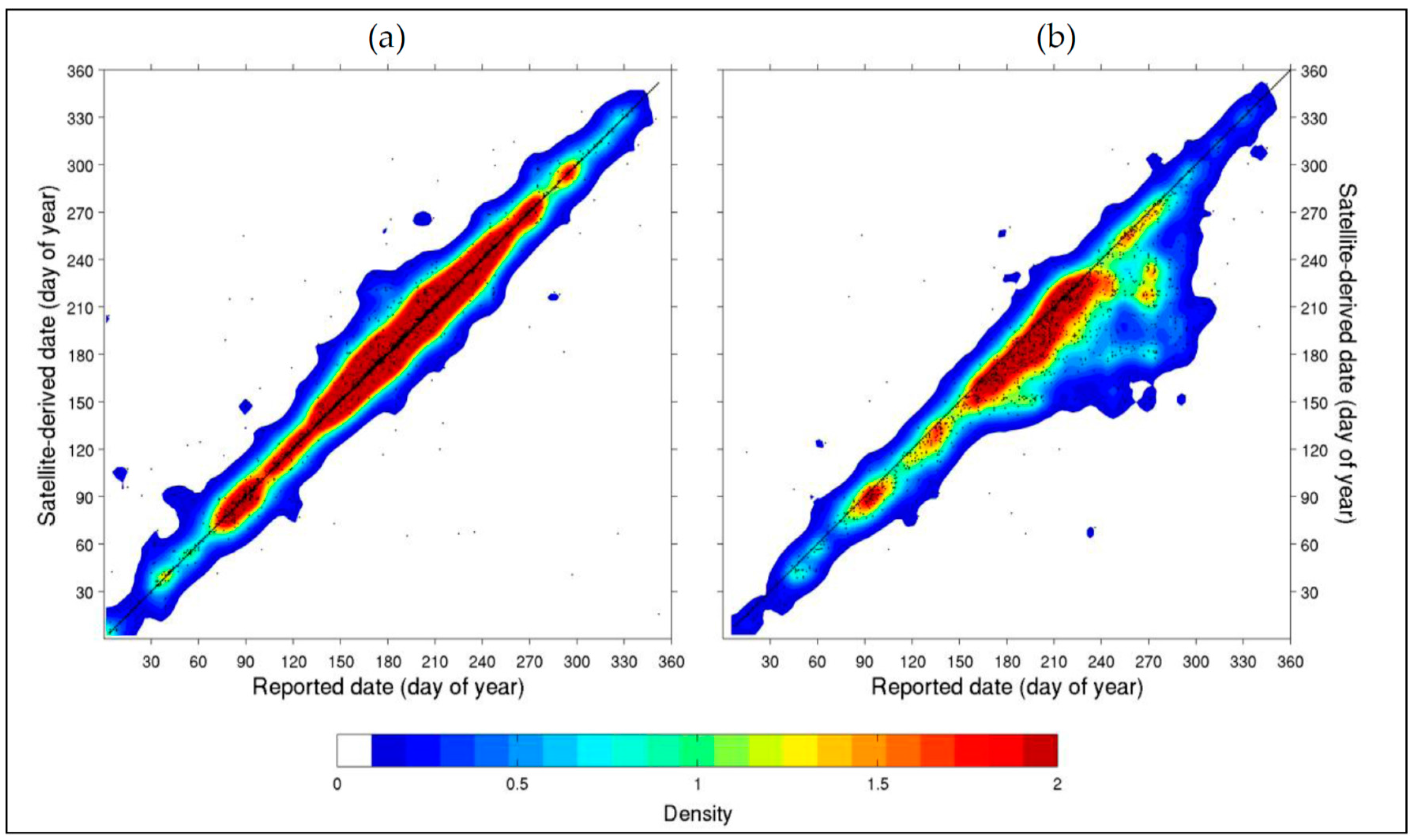
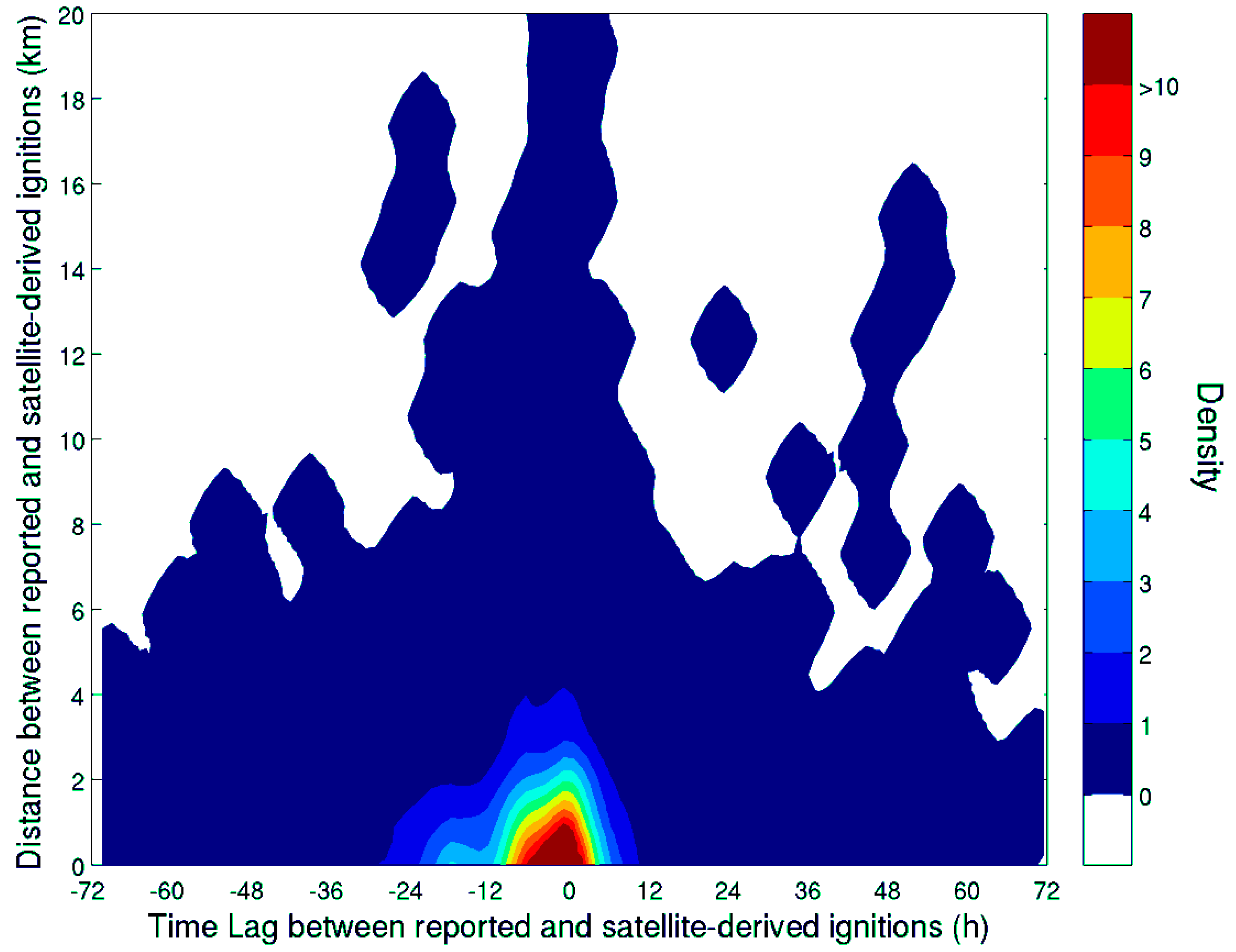
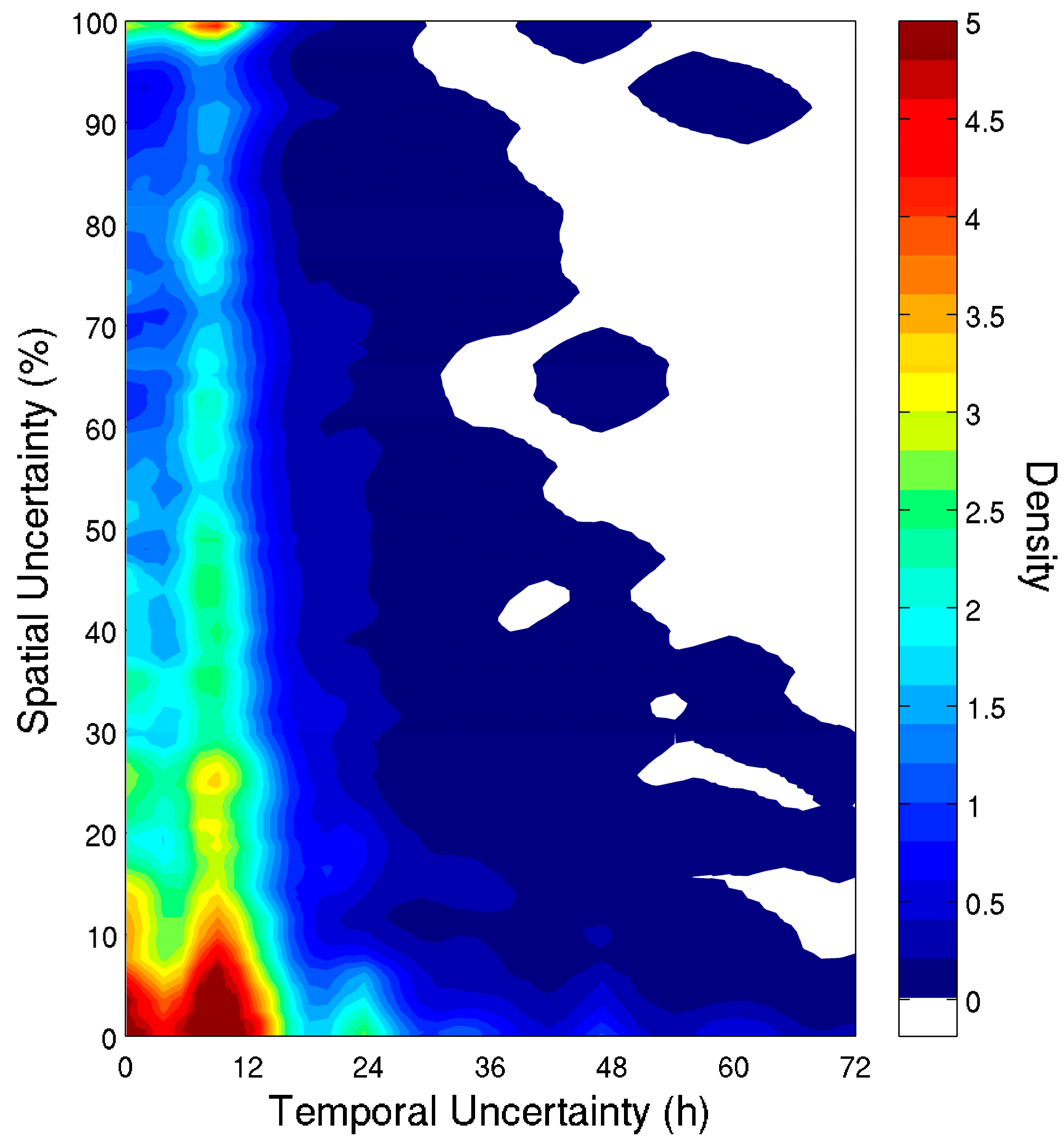
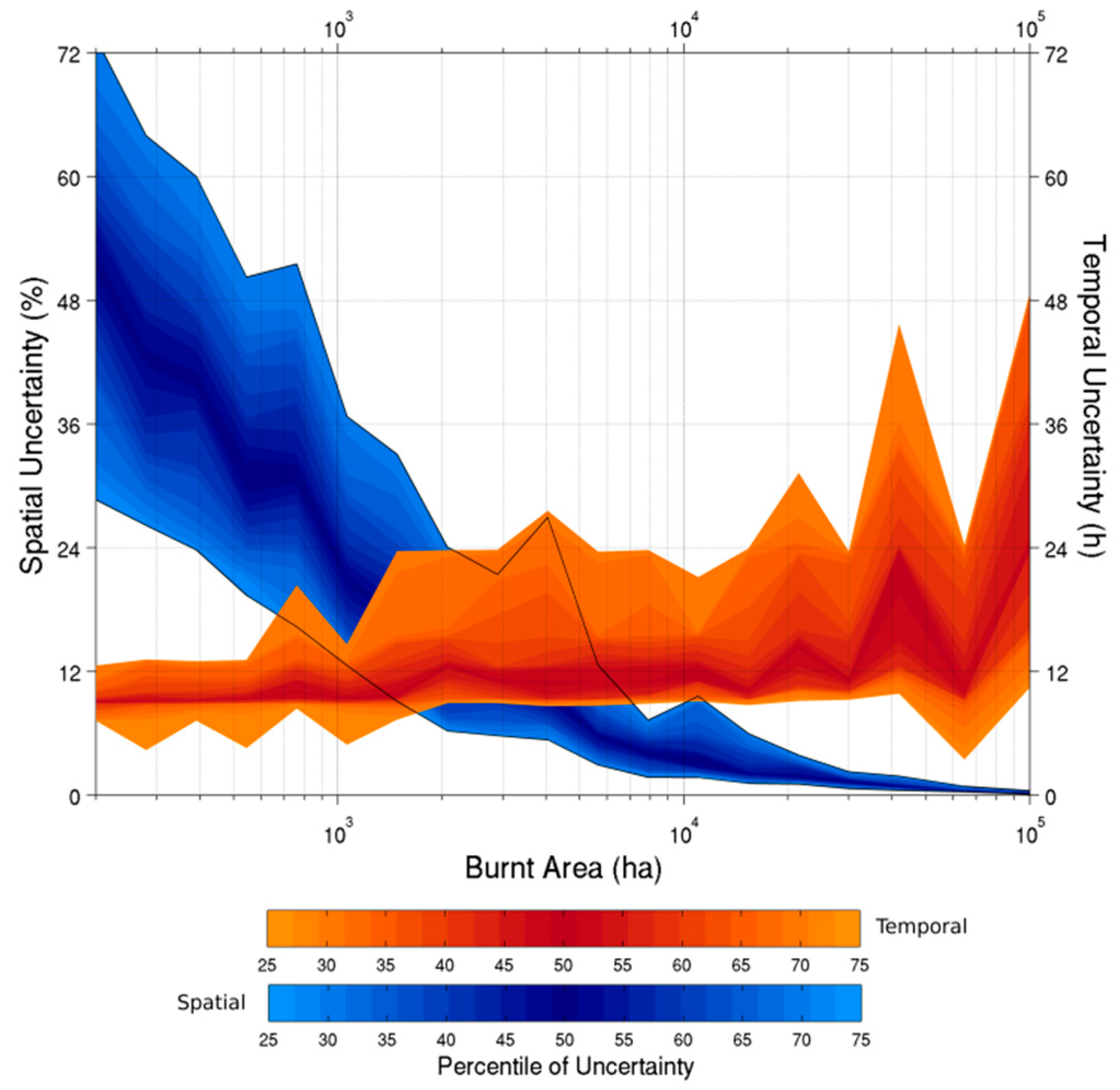
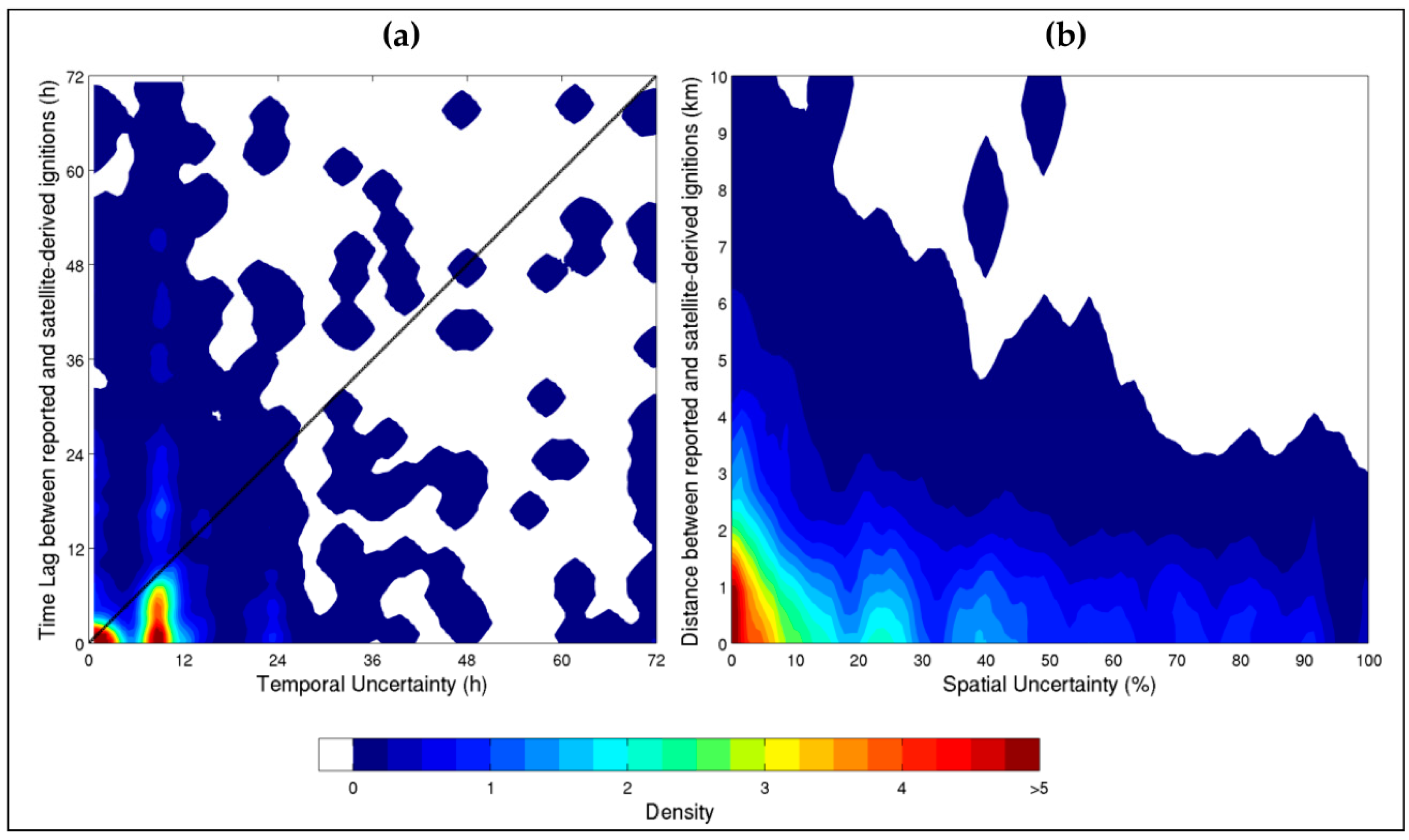

| Region | Fire Perimeters | Fire Dates | Ignitions | Sources |
|---|---|---|---|---|
| Portugal | 2000–2009 | 2001–2009 | 2001–2009 | [45,46] |
| Alaska | 2000–2013 | 2001–2013 | 2001–2010 | [21,47] |
| California | 2000–2011 | 2001–2011 | 2001–2010 | [21,48] |
| Greece | 2000–2011 | 2000–2007 | 2000–2007 | [49,50] |
| SE Australia | 2000–2011 | 2000–2011 | 2000–2008 | NSW Office of Environment and Heritage (unpublished data) |
| Satellite-Derived Data Available | Satellite-Derived Data Unavailable | |
|---|---|---|
| Reported Data Available | 74.5 (86.6) | 15.4 (6.2) |
| Reported Data not Available | 8.0 (5.0) | 2.1 (2.3) |
| Region | Start Date | End Date |
|---|---|---|
| Portugal | 0.77 (394) | 0.41 (139) |
| Greece | 0.69 (12) | 0.85 (11) |
| Alaska | 0.79 (564) | −0.28 (503) |
| California | 0.94 (589) | 0.77 (212) |
| SE Australia | 0.88 (766) | 0.89 (532) |
| All Regions | 0.91 (2325) | 0.73 (1397) |
© 2016 by the authors; licensee MDPI, Basel, Switzerland. This article is an open access article distributed under the terms and conditions of the Creative Commons by Attribution (CC-BY) license (http://creativecommons.org/licenses/by/4.0/).
Share and Cite
Benali, A.; Russo, A.; Sá, A.C.L.; Pinto, R.M.S.; Price, O.; Koutsias, N.; Pereira, J.M.C. Determining Fire Dates and Locating Ignition Points With Satellite Data. Remote Sens. 2016, 8, 326. https://doi.org/10.3390/rs8040326
Benali A, Russo A, Sá ACL, Pinto RMS, Price O, Koutsias N, Pereira JMC. Determining Fire Dates and Locating Ignition Points With Satellite Data. Remote Sensing. 2016; 8(4):326. https://doi.org/10.3390/rs8040326
Chicago/Turabian StyleBenali, Akli, Ana Russo, Ana C. L. Sá, Renata M. S. Pinto, Owen Price, Nikos Koutsias, and José M. C. Pereira. 2016. "Determining Fire Dates and Locating Ignition Points With Satellite Data" Remote Sensing 8, no. 4: 326. https://doi.org/10.3390/rs8040326
APA StyleBenali, A., Russo, A., Sá, A. C. L., Pinto, R. M. S., Price, O., Koutsias, N., & Pereira, J. M. C. (2016). Determining Fire Dates and Locating Ignition Points With Satellite Data. Remote Sensing, 8(4), 326. https://doi.org/10.3390/rs8040326









